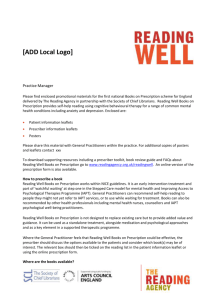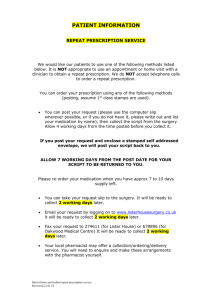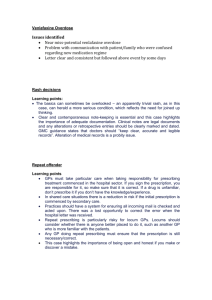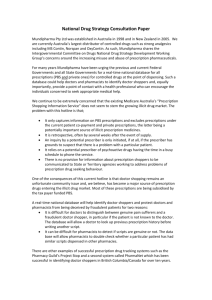PPA - EDUCATION - Advanced Search
advertisement
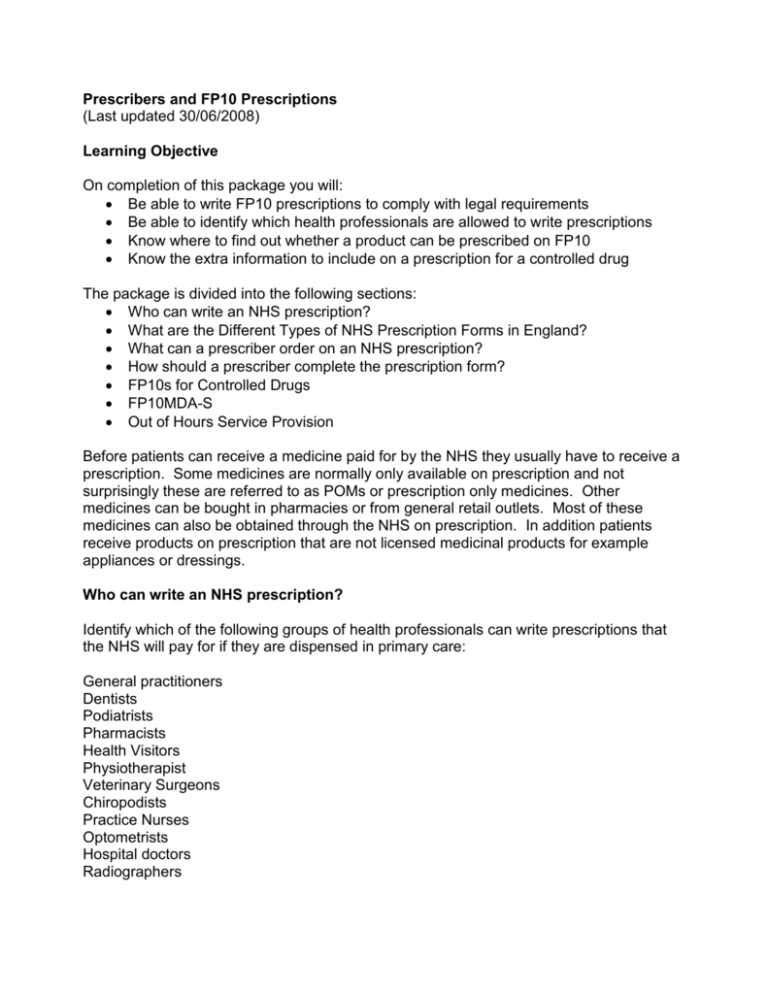
Prescribers and FP10 Prescriptions (Last updated 30/06/2008) Learning Objective On completion of this package you will: Be able to write FP10 prescriptions to comply with legal requirements Be able to identify which health professionals are allowed to write prescriptions Know where to find out whether a product can be prescribed on FP10 Know the extra information to include on a prescription for a controlled drug The package is divided into the following sections: Who can write an NHS prescription? What are the Different Types of NHS Prescription Forms in England? What can a prescriber order on an NHS prescription? How should a prescriber complete the prescription form? FP10s for Controlled Drugs FP10MDA-S Out of Hours Service Provision Before patients can receive a medicine paid for by the NHS they usually have to receive a prescription. Some medicines are normally only available on prescription and not surprisingly these are referred to as POMs or prescription only medicines. Other medicines can be bought in pharmacies or from general retail outlets. Most of these medicines can also be obtained through the NHS on prescription. In addition patients receive products on prescription that are not licensed medicinal products for example appliances or dressings. Who can write an NHS prescription? Identify which of the following groups of health professionals can write prescriptions that the NHS will pay for if they are dispensed in primary care: General practitioners Dentists Podiatrists Pharmacists Health Visitors Physiotherapist Veterinary Surgeons Chiropodists Practice Nurses Optometrists Hospital doctors Radiographers Follow this link to check your answers. To enable the NHS to pay for medicines dispensed in primary care the correct prescription form has to be used. Prescribers use different prescription forms in Scotland and Wales to those in England. The bottom section of the prescription is printed with details of the prescriber such as his or her name and with information that identifies the contract to which the cost of the medicine will be charged. Each prescriber has his or her own number so that ultimately the person responsible for prescribing the medicine can be identified. Primary care organisations such as general practices and Primary Care Trusts are allocated budgets to cover the cost of prescribing. The following can write NHS prescriptions: Most prescriptions are written by General Practitioners. Sometimes doctors working in NHS hospitals write prescriptions for patients to take to community pharmacies (Chemists). This is usually in situations where the hospital pharmacy department cannot supply the medicine. Doctors working in hospital out-patient drug addiction clinics can also issue special NHS prescriptions. Dentists can prescribe for their NHS patients Some nurse practitioners have qualified as independent prescribers. This means that they can draw up a management plan and initiate therapy for the patients they treat unlike supplementary prescribers. There are two groups of independent nurse prescribers: (a) Community Practitioner Nurse Prescribers who qualified under the original arrangements for nurse prescribing and (b) Nurse Independent Prescribers (formerly known as Extended Formulary Nurse Prescribers). The first group have to hold either a district nursing qualification or be registered as a health visitor and they have to have completed an approved training course (this training is now part of the university-based specialist practitioner programmes for new district nurses and health visitors). The second group of nurses must be a 1st level Registered Nurse or Registered Midwife or a Registered Specialist Community Public Health Nurse who has completed the specific programme of preparation for Nurse Independent prescribing. For both groups of nurses, they have to be registered in the register maintained by the Nursing and Midwifery Council (NMC) with an appropriate annotation next to their name indicating the type of nurse prescriber. Pharmacist Independent Prescribing was introduced from 1st May 2006. To qualify they must be a registered pharmacist whose name is held on the membership register of the Royal Pharmaceutical Society of Great Britain with an annotation signifying that the pharmacist has successfully completed an education and training programme accredited by the RPSGB and is qualified as an independent prescriber. Optometrist Independent Prescribing was introduced from 4th June 2008. Once training is completed practitioners will need to register their independent prescribing specialty with the General Optical Council before they can exercise prescribing responsibilities. The Department of Health has introduced supplementary prescribing, which is “A voluntary prescribing partnership between an independent prescriber and a supplementary prescriber, to implement an agreed patient-specific clinical management plan with the patient’s agreement”. Supplementary prescribers are able to prescribe from a range of medicines for a broad range of medical conditions under the terms of a clinical management plan. The plan will be drawn up, with the patient’s agreement, in consultation with an independent prescriber. The independent prescriber is a doctor or a dentist. The supplementary prescriber is either a Registered Nurse, Registered Midwife or Registered Pharmacist. Nurses can hold more than one qualification e.g. as a Nurse Independent Prescriber and also as a supplementary prescriber. In May 2004, the DH proposed that allied health professionals, including physiotherapists, radiographers, chiropodists and optometrists, should be able to prescribe medicines, as supplementary prescribers in partnership with a doctor. The introduction of supplementary prescribing by these health professionals was implemented in April 2005 to allow AHP’s to train as supplementary prescribers. These changes in who can prescribe result from the implementation of the Crown Report . Follow this link for more information about nurse prescribing, pharmacist prescribing and supplementary prescribing click here. What are the Different Types of NHS Prescription Forms in England? Different types of prescribers use different versions of the standard NHS FP10 prescription form. Each version is a different colour, which helps the dispenser and the NHS Prescription Services to identify the prescriber. The different versions of the FP10 also have different codes. For the following codes, name the prescriber who uses the form: - FP10P FP10MDA-SS FP10NC FP10D FP10SS FP10HNC FP10MDA-S FP10HMDA-S FP10MDA-SP FP10PCD Follow this link to check your answers. The FP10 form has been redesigned in the last few years to make counterfeiting of the form more difficult, for example special dyes are used. Other measures introduced to reduce patient charge evasion have resulted in the back of the form being changed as well. The back of the form specifies exemption categories for patients who don't pay the prescription charge and these have been updated following the introduction of new types of social benefits. An example of an FP10 form is shown below. enlarge Front FP10 form Back FP10 form The following groups of prescribers use these various forms: GPs – FP10NC, FP10SS, FP10MDA-SS, FP10MDA-S Hospital-based prescribers - FP10SS, FP10MDA-SS, FP10HNC, FP10HMDA-S Dentists - FP10D Nurses - FP10P, FP10SS, FP10 MDA-SS Supplementary prescribers – FP10P, FP10SS, FP10 MDA-SS, FP10MDA-SP OOH - FP10P-REC Private prescribers - FP10PCD Form FP10MDA-S is used for prescribing controlled drugs (mainly methadone) to addicts. It is twice the size of the standard FP10 because it contains space for the pharmacist to record each time an instalment is supplied. FP10SS forms are designed for use with the prescriber’s computer system. Many prescriptions are produced in this way and they are usually easier to read than hand-written prescriptions. FP10NC are for hand-written prescriptions. The FP10P is printed with information to indicate the type of prescriber: COMMUNITY PRACTITIONER NURSE PRESCRIBER - the original group of nurse prescribers NURSE INDEPENDENT PRESCRIBER - nurses formerly known as Extended Formulary Nurse Prescribers SUPPLEMENTARY PRESCRIBERS OUT OF HOURS CENTRES The FP10PCD was introduced to support the DH project for safer management of CDs and is used for any private prescriptions for schedule 2 & 3 controlled drugs dispensed by community pharmacists. It is printed with information to indicate the type of private prescriber: PRIVATE DOCTOR PRIVATE NURSE PRESCRIBER PRIVATE PHARMACIST PRESCRIBER PRIVATE OPTOMETRIST PRESCRIBER PRIVATE PHYSIOTHERAPIST PRESCRIBER PRIVATE RADIOGRAPHER PRESCRIBER PRIVATE PODIATRIST PRESCRIBER What can a prescriber order on an NHS prescription? What do you think prescribers should be allowed to order on prescriptions - anything they think the patient needs? How about a regular session of exercise or a daily helping of fruit for a patient who requires vitamins? These suggestions are not as daft as you might suppose. There have to be limitations on what can be prescribed at NHS expense and it is important that prescribers only prescribe within their own competencies. How do you think this might affect prescribing by dentists or nurses? Why not discuss these issues with your colleagues or tutor. Follow the links to find out more. General Medical Services (GMS) contract Drugs and other substances not to be prescribed under the NHS Pharmaceutical Services Drugs and other substances to be prescribed in certain circumstances under the NHS Pharmaceutical Services Appliances Borderline substances Dental Practitioners Formulary Nurse Prescribers Formularies Supplementary Prescribing Pharmacist Independent Prescribing Optometrist Independent Prescribing General Medical Services (GMS) Contract The Standard General Medical Services Contract states that: "A prescriber shall order any drugs, medicines or appliances which are needed for the treatment of any patient who is receiving treatment under the contract by issuing to that patient a prescription form or a repeatable prescription and such a prescription form or repeatable prescription shall not be used in any other circumstances." This means that the prescriber can't use the FP10 form to prescribe exercise sessions. The General Medical Services (GMS) contract was introduced in April 2004. The contract is between the primary care organisation (PCO) and the primary care practice as opposed to a contract with each GP. The contract includes proposals to help GPs to manage their workload by enabling practices to transfer responsibility for providing some services, including out-of-hours care, to their PCO. Under the terms of the contract a practice can decide which additional and enhanced services they wish to provide, for example, contraceptive services, childhood vaccinations and minor surgery. If the practice opts out the PCO becomes responsible for the service provision. Drugs and other substances not to be prescribed under the NHS Pharmaceutical Services In practice there are some restrictions on what a GP can prescribe on FP10. Schedule 1 to the NHS (General Medical Services Contract) (Prescription of Drugs etc) Regulations 2004 lists drugs and other substances not to be prescribed under the NHS pharmaceutical services. This list can be found in Part XVIIIA of the Drug Tariff. If an FP10 prescription is dispensed for an item on this list, no reimbursement is made to the contractor for that item. Drugs and other substances to be prescribed in certain circumstances under the NHS Pharmaceutical Services Schedule 2 to the NHS (General Medical Services Contract) (Prescription of Drugs etc) Regulations 2004 lists drugs to be prescribed in certain circumstances under the NHS pharmaceutical services. It specifies groups of patients who may receive specific drugs for specific purposes. These drugs can not be prescribed to other types of patient or for different purposes. The list of drugs covered by Schedule 2 is usually referred to as theSelected List and it can be found in Part XVIIIB of the Drug Tariff. If one of these drugs is prescribed, the GP must endorse the face of the FP10 with the reference “SLS”. Appliances Unlike drugs where a GP can prescribe any drug that is not in Schedule 1, only the appliances listed in Part IX of the Drug Tariff can be supplied on FP10. If an appliance not listed in the Drug Tariff is dispensed or an appliance that does not conform to the Drug Tariff specification, no reimbursement will be made to the dispensing contractor for that appliance. Borderline substances The products that GPs prescribe on FP10 do not have to have marketing authorisations (product licences) to be considered as drugs. Some patients will require unlicensed medicines. There are also patients who need products where it is borderline whether the product is a drug or something else such as a food or cosmetic. Whether a product is allowed as a drug on an FP10 may depend on the particular circumstances in which the product is used e.g. it may be considered a drug when used for treating a specific condition. The Advisory Committee on Borderline Substances advises as to the circumstances in which some foods and toilet preparations may be regarded as drugs. The ACBS recommendations can be found in Part XV of the Drug Tariff. If a GP prescribes one of these substances, he or she should endorse the FP10 with "ACBS". Dental Practitioners Formulary Unlike GPs, dentists are restricted to a specific list of products that they can prescribe on FP10D. The NHS Prescription Services will only reimburse the dispensing contractor if the products are in the formulary. You can find the list of preparations which may be prescribed on form FP10D as Part XVIIA of the Drug Tariff. Nurse Prescribers Formularies There are two groups of independent nurse prescribers. Community Practitioner Nurse prescribers who have completed the necessary training can only prescribe the preparations listed in Part XVIIB(i) of the Drug Tariff. The list includes almost all appliances (including wound management products) and reagents listed in Part IX. The second group, Nurse Independent Prescribers, can prescribe any licensed medicine for any medical condition, including some Controlled Drugs listed in Part XVIIB(ii) and must work within their own level of professional competence and expertise. Supplementary Prescribing Supplementary prescribers can prescribe the following, provided they are included within the patient-specific clinical management plan: All General Sales List medicines, Pharmacy medicines, appliances and devices, foods and other borderline substances approved by the Advisory Committee on Borderline Substances. All POMs. Controlled Drugs (except those listed in Schedule 1 of 'The Misuse of Drugs Regulations 2001' - that are not intended for medicinal use). (The current exception is when an AHP is the supplementary prescriber) Medicines for use outside their licence indications. Unlicensed drugs (a product not licensed in the UK). Pharmacist Independent Prescribing Pharmacist Independent prescribers, as stated in Part XVIIB(ii) of the Drug Tariff, are able to prescribe any licensed medicine for any medical condition but cannot prescribe Controlled Drugs. Optometrist Independent Prescribing Optometrist Independent prescribers can prescribe any ophthalmic medication for any eye condition and must work within their own level of professional competence. How should a prescriber complete the prescription form? FP10 forms have to be completed in accordance with legal requirements such as the Medicines Act (if the drug is a POM) and the Misuse of Drugs Act (if the product contains a controlled drug). The NHS (General Medical Services Contract) Regulation 2004 also contains some requirements for writing prescriptions: these apply to all prescriptions regardless of whether the item prescribed is a drug or an appliance. Which of the following pieces of information does a prescriber have to include on an FP10 prescription to meet legal requirements? Patient's date of birth Patient's name Patient's title e.g. Mr Quantity of the product to be supplied Prescriber's qualifications The date the prescription was signed Instructions to the patient on how to use the product Prescriber's signature Follow this link to check your answers. Which of the following statements about prescriptions are true? Carbon paper can be used to write FP10 prescriptions provided the prescriber signs each copy of the prescription in indelible ink FP10 prescriptions can contain an instruction to allow repeat dispensing of the same prescription A doctor can write a single prescription for a POM to treat more than one patient An FP10 prescription is normally valid for 6 months from the date on the prescription Follow this link to check your answers. A prescriber should include the following on an FP10 prescription: The prescriber's signature - this should include his or her initials, or forenames, and surname. Electronic signatures or stamps are not currently permitted on paper prescriptions. To allow the pilots for electronic transmission of prescriptions to go ahead in England, the Prescription Only Medicines Order was amended to allow authorised prescribers who were participating in the pilot schemes to sign prescriptions digitally in place of ink signatures. The prescriber's address - this is usually the practice address for a GP or dentist and it is already printed on the FP10. For a nurse employed by a Primary Care Trust, the trust's address is printed on the form and the nurse has to add a code that identifies the patient's GP practice. Particulars to indicate whether the prescriber is a doctor, dentist, nurse or pharmacist this does not have to be the prescriber's qualifications. FP10s contain a number to identify the prescriber. A date must appear on the FP10 next to the prescriber's signature. For most prescriptions this is the date the prescriber signed the prescription but the prescriber is also allowed to put a date before which the prescription should not be dispensed. Patient's details - name and address must be given but the format for this information is not specified. It's not essential to give the patient's title but it can be helpful. For patients under 12 years, the age or date of birth must be stated but this is not required for older patients. GP computer systems should print the age or date of birth on the FP10 for all patients and this information is very useful for the pharmacist. Information about the product supplied - apart from some controlled drugs (see next section) there is no legal requirement to provide particular information about the product. The Terms of Service require a doctor to insert particulars of the order on the form but do not specify what these particulars include. The NHS Prescription Services obviously needs sufficient information about the product to price the prescription and pay the dispensing contractor accurately. If there is insufficient information on the FP10, it has to be returned to the dispensing contractor who then has to make sure the information is added. The form is then returned to the NHS Prescription Services and this will delay the payment to the dispensing contractor for that FP10. To be sure that the product meets the prescriber's requirements, information missing from the FP10 such as the quantity of the product can not be written on the main body of the FP10 by a pharmacist. When information is missing the pharmacist usually returns the FP10 to the prescriber. In some circumstances the pharmacist can use his or her discretion as to what to supply so that the patient is not deprived of a product that he or she requires immediately. Follow this link to find out how a dispenser can endorse a prescription form when information is missing: How to prevent common endorsing errors The instructions for how to take or use the product do not have to appear on the prescription. If this information is missing, the pharmacist will usually check the patient understands the prescriber's intentions and advise the patient using the pharmacist's professional knowledge. The British National Formulary contains advice for prescribers on how to write prescriptions clearly. This covers hand-written prescriptions and computer issued prescriptions. The advice for writing prescriptions by hand can be found on our website in the NHS Prescription Services section under Prescription Form. Prescribers and dispensers also need to know the following about FP10 prescriptions: FP10 prescriptions can be written using carbon paper or similar material providing they are not for a Schedule 2 or Schedule 3 controlled drug. Carbon copies of the prescription can be useful if the prescriber wants only a small quantity of a drug to be dispensed and the identical prescription is being given two or three times. The prescriber must sign and date each carbon copy. Repeat dispensing of an FP10 prescription allows patients to obtain a prescription from their GP which they can have dispensed in several episodes, rather than having to go back to the surgery each time for a new prescription. For repeat dispensing the prescriber’s software system produces a repeatable prescription on an FP10 and a further series of ‘batch issues’ (also printed on FP10s) of up to a year’s duration. The repeatable prescription contains all the usual details i.e. name and address of patient, age, date of birth, prescriber details, signature and date. The prescriber is required to specify the number of issues he/she wishes to permit from this prescription. The prescriber signs the repeatable prescription because this is the legal prescription, as defined by the Medicines Act, needed by the dispenser at each dispensing episode. The ‘batch issues’ are not signed by the prescriber since they are not prescriptions but are used for reimbursement purposes. The computer system annotates the FP10 form so that the dispenser can distinguish when an FP10 is being used for repeat dispensing rather than for a normal single-event FP10. Systems also link the number of batch issues by overwriting the prescriber signature box on each batch issue form with text "Repeat dispensing: [example] 6 of 12". The date on which the repeats were authorised is printed on all the batch issues. The pharmacy will retain the repeatable prescription and the patient can keep the remaining batch issues or ask the pharmacist to retain them on his/her behalf until the next issue of medication. The patient signs each batch issue form at the time it is dispensed. The dispenser processes batch issues and forwards the forms to the NHS Prescription Services at the end of the month dispensed. The repeatable prescription is sent to the NHS Prescription Services once all batch issues have been dispensed or, if the patient does not collect all instalments, on expiry. When the patient collects their medicine the pharmacist has an opportunity to confirm that the prescription still meets their needs and to answer any questions they may have. Follow this link for more information: Repeat dispensing A separate prescription form has to be used for each patient, except where a doctor is prescribing in bulk for a school or institution. POMs can not be prescribed on "bulk prescriptions". The Drug Tariff specifies the requirements that have to be met before a "bulk prescription" can be issued. This information can be found in Part VIII, Notes, Paragraph 9 of the Drug Tariff, and can be viewed online at: www.nhsbsa.nhs.uk/prescriptionservices/PaymentsandPricing/DrugTariff An FP10 prescription can be dispensed up to 6 months from the date on the prescription except : if the FP10 is for a Schedule 2 or Schedule 3 controlled drug or if the FP10 is a repeatable prescription. FP10s for Controlled Drugs When a doctor or dentist writes a prescription for a controlled drug, he or she also has to comply with the requirements of the Misuse of Drugs Act. In practice there are only extra requirements for Schedule 2 and Schedule 3 controlled drugs. Prescriptions for Schedule 4 and Schedule 5 controlled drugs just have to meet the requirements for writing prescriptions for POMs. The prescriber must ensure the FP10 contains the following additional information: The prescriber's usual signature and the date If issued by a dentist, "for dental treatment only" The name and address of the patient The dose of the drug to be taken In the case of preparations, the form and, where appropriate, the strength of the preparation Either the total quantity of the preparation or the number of dose units in both words and figures, with a strong recommendation that the maximum quantity is limited to 30 days for schedule 2, 3 & 4 controlled drugs. FP10s for temazepam do not have to comply with the above requirements. Validity of prescriptions for schedule 2, 3 & 4 controlled drugs is now restricted to 28 days. FP10MDA-S The FP10MDA-S prescription form is used to order Schedule 2 controlled drugs and buprenorphine for supply by instalments for treatment of addiction. When a GP writes an FP10MDA-S, he or she must specify the number of instalments to be dispensed and the interval between each instalment. The GP can only order a sufficient quantity of the drugs as will provide treatment for not more than 14 days. A starting date for dispensing the instalments does not have to be specified but if such a date is given, it must be complied with and the instalment directions run from that date. Other drugs the patient might require (besides those for treating addiction) can not be ordered on an FP10MDA-S. Out of Hours (OOH) service provision Non FP10 Supply Forms (which are sometimes referred to as FP10P-REC forms) were introduced in 2005 for use specifically within Out of Hours Centres. However, other FP10 prescriptions also remain available for use in the more traditional OOH prescribing scenario, where the patient is visited by a prescriber outside of normal working hours. This overview is intended to clarify the circumstances in which each type of form should be used. PCTs (or their Prescription Form Purchasing & Distribution Unit / Agency) will need to supply the different types of form to OOH service providers (all form types are obtainable from the usual suppliers). These are: Non FP10 Supply Forms - FP10P-REC The Non-FP10 Supply Form was designed for a specific purpose - to support the introduction of Out of Hours Centres in February 2005. These OOH Centres provide patients with an opportunity to receive any urgently required medication at the same time and place as the out of hours consultation. The FP10P-REC forms should only be used by the OOH provider to record items supplied directly to a patient on-site (i.e. an item not dispensed through a community pharmacy). These forms should be submitted by the OOH provider to the NHS Prescription Services of the NHS Business Services Authority on a monthly basis (by the 5th working day). This will enable the NHS Prescription Services to provide monitoring and reporting information. FP10P-REC forms should not be dispensed through traditional community pharmacies, as they are not intended for patients to take away from the OOH Centre and exchange for medication. Standard FP10 Prescriptions These are the standard FP10 prescription forms that will be dispensed by a community pharmacy. They can either be computer-generated type (FP10SS) or hand-written prescriptions (FP10NC). Or alternatively, FP10P forms for any qualified nurse or pharmacist prescribers. In an OOH setting these forms should continue to be used where prescribing takes place outside of normal working hours, but where there is no immediate treatment required (i.e. where it is not detrimental to the patient to wait until the prescription can be dispensed at a later point by a community pharmacy). Click here for a copy of the original letter communicating the creation of the Out of Hours Centre initiative. This describes the initiative in more detail and also explains the steps that PCTs need to take in order to set up these sites. Further reading Drug Tariff. The Stationery Office, London Electronic Drug Tariff The NPA Guide to the Drug Tariff and NHS Dispensing for England and Wales. The National Pharmaceutical Association, St Albans. Medicines, Ethics and Practice A Guide for Pharmacists, Royal Pharmaceutical Society of Great Britain, London Crown Report - Review of Prescribing, Supply and Administration of Medicines, NHS Executive Department of Health General Medical Services (GMS) contract NHS repeat dispensing schemes in England Nurse prescribing Pharmacist Prescribing Supplementary prescribing


